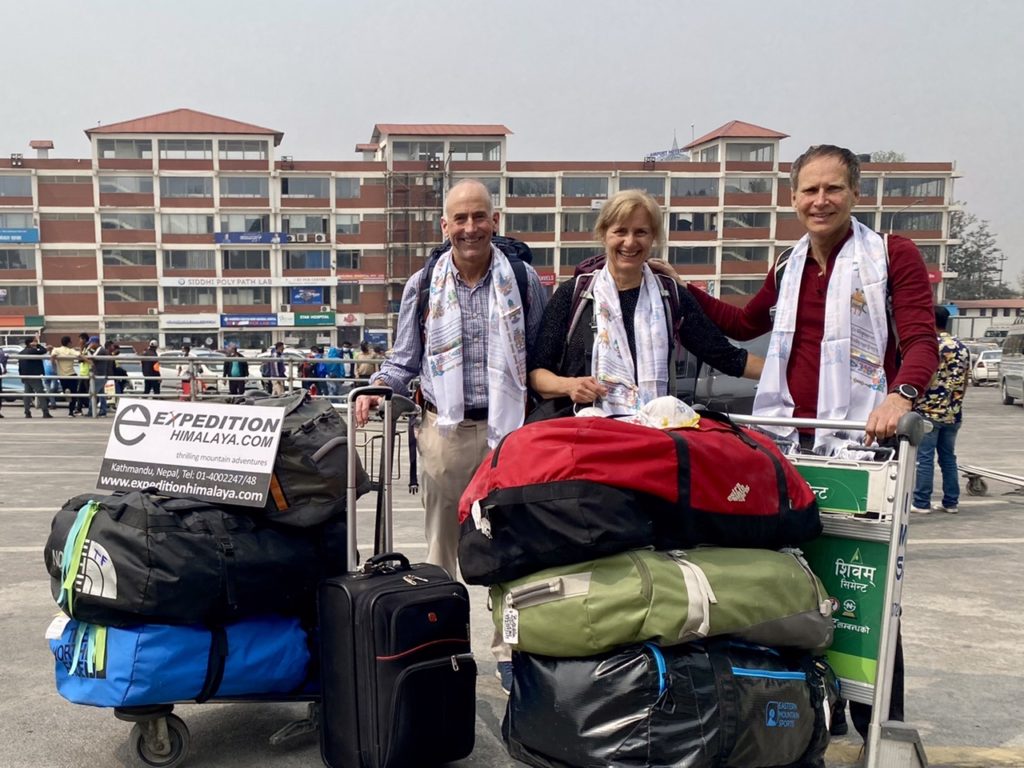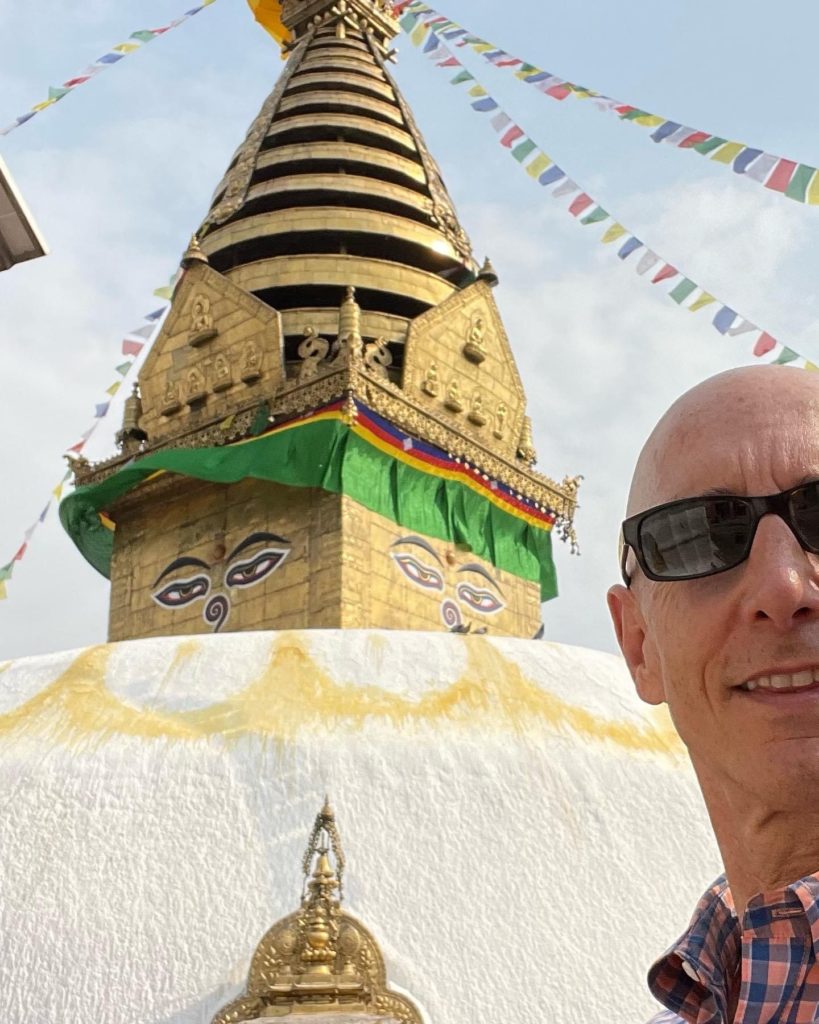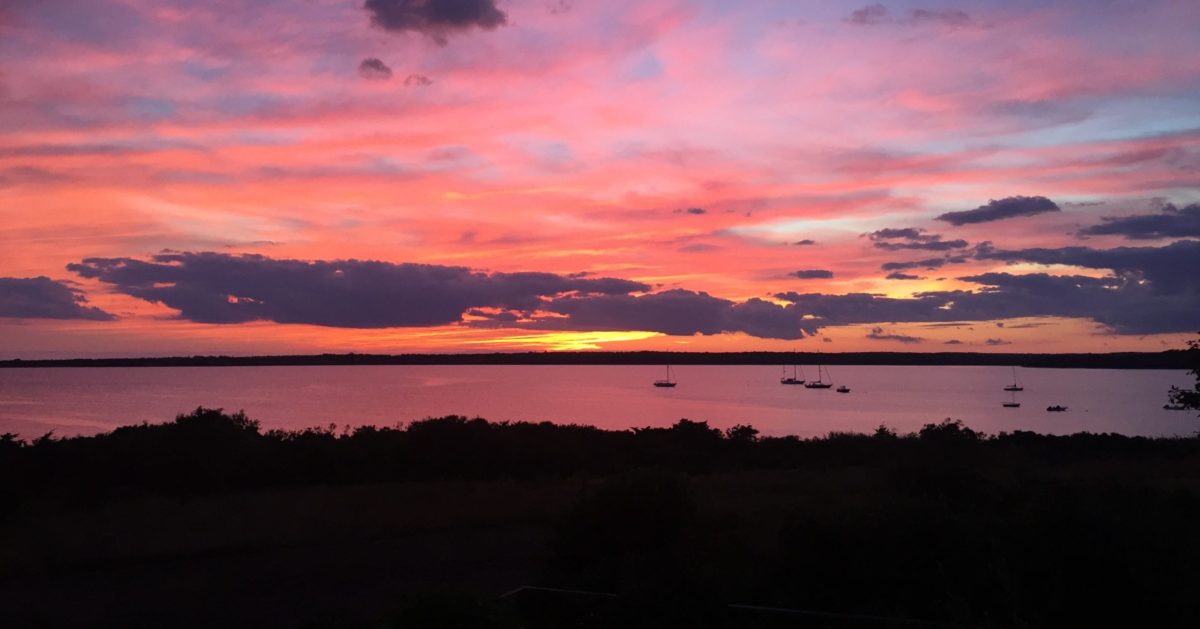A couple of nights ago, Jill dropped me at Logan airport and I repeated the same journey I made a year ago: Qatar Airways to Doha, an eight hour layover in one of the nicest airport lounges on the planet, then another Qatar flight to Kathmandu. There was a great view of the Annapurna range out the window shortly before landing.

When I arrived in Kathmandu last year, my frame of reference compared it to a place I had experienced in the early 1980’s and 90’s, when I soaked up the Shangri-La vibe and used it as a base for outdoor adventures that became cherished life memories.
My return this year feels different. My frame of reference is strongly linked to last year, when I arrived in Kathmandu eagerly preparing to climb Everest, and then returned after almost two months, replaying in my mind an aborted summit attempt and a challenging descent through a blizzard. The post climb week I spent quarantined at the Yak and Yeti hotel, with the city in full Covid lockdown, was intense and full of reflection; one of those intersections of time and place that stay with you for a long while.
So when I arrived yesterday at Kathmandu’s Tribhuvan airport, I wasn’t thinking about how it looked when I first landed here in 1982. Then, I stood outside a small customs building on a grass-lined runway, savoring the mountain air and the sunlight filtering through the trees. Instead, as we left the crowded, sprawling airport yesterday and drove through chaotic streets full of cars and motorcycles, I was thinking back to last year’s arrival. We drove the exact same route to the hotel. The sights out the window were the same. It had the feeling of ritual. As I re-entered the Yak and Yeti, I felt like I was being teleported back twelve months to that same intense intersection of time and place.
It is good to be back. I continue to mourn the population growth, vehicular traffic, and air pollution that have turned what used to be an exotic valley town into a crowded Asian city. But Kathmandu remains a fascinating place, and the Nepali people remain astoundingly friendly and polite. I am also excited about what I am here to do, which includes more than just repeating last year’s climb.
A different approach
I am climbing Everest with a different team this year, and will explain more about that in a future post. I am also approaching base camp by a different route, accompanied by good friends Bob Burnham, Ann Burnham, and Brad Brown. Here is a photo of Bob, Ann, and I upon arrival at Kathmandu airport:

Brad had arrived a couple of days ahead of us. Here is photo of him taking the town by storm:

photo credit: Brad Brown
Our trek will take us through the relatively remote territory east of Everest to the base of Makalu, the fifth highest mountain in the world. Brad and Ann will then helicopter back to Kathmandu and fly home. Bob and I will continue over a series of high passes and drop down into the Everest region. The remoteness of the area requires us to be self sufficient, with porters assisting in carrying all the supplies and gear necessary for the three week journey. The high passes will involve some technical climbing at altitudes around 20,000 feet, as well as extended glacier travel. We will be supported by experienced Sherpa guides.
Here is a photo from Google Earth that provides an overview. The red line shows the standard trek route from Lukla to Everest base camp, through the heart of the Solu-Khumbu region. This is the approach I did last year, and the approach the rest of my Everest team will do this year. The blue line shows the route Bob, Ann, Brad, and I will follow through the Makalu-Barun region, starting from the village of Num in the lower right corner. (Num is not labeled. It is at the top of the squiggly yellow line, which is a dirt road built recently to facilitate construction of a dam on the Arun river.) Makalu base camp, where Ann and Brad will depart the trek, is located on a glacier near the “M” in Makalu. The village of Dingboche, where Bob and I will conclude our traverse of the high passes, is in the upper left, where the blue and red lines connect. I will meet my Everest team here, and then head north on the red line to Everest base camp. Bob will head south on the red line to Lukla, from where he will fly back to Kathmandu.

As mentioned in a previous post, the “Makalu Three Passes” trek has intrigued me since hearing about it over thirty years ago. When I decided to return to Everest, I liked the idea of injecting a new element of life experience into the equation. The area is far removed from the trekking mainstream, the terrain will be stunning, and the idea of climbing over high passes from one mountain region to another excites me. It will also be great to share the experience with friends. At the same time, I need to be mindful and conserve energy. It will be important to arrive at Everest base camp with mental and physical batteries fully charged.
The past day and a half have been filled with tactical details: obtaining stacks of rupee notes to pay the porters, submitting paperwork for permits, doing a final gear check, and handing off a large duffel of equipment that will be sent directly to Everest base camp to await my arrival. I am leaving a small duffel here at the hotel, with clean clothes and other items, for my return in a couple of months. As I packed it, I was thinking about how much will play out between now and then, and how many hopes and dreams are in the mix.
We fly tomorrow morning to a town named Tumlingtar, in the lowlands south of the Makalu region. From there we will hop in a jeep for a bumpy five hour ride up to Num, spend the night, and then start walking. The flights are notorious for weather-related issues, and the one to Tumlingtar was cancelled yesterday and today. We are hoping for better luck tomorrow, but will get there one way or the other.
In contrast to the Everest region, internet service in the Makalu-Barun is essentially non existent. The next time I post something will likely be from Dingboche, which Bob and I should reach around April 20. I should have lots to report.
Thanks for following along!






